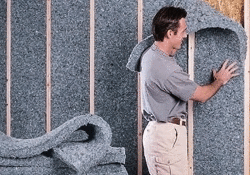ACOUSTICAL SOUNDPROOFING WINDOWS and curtains

Acoustical soundproofing Window Curtains Acoustical soundproofing window curtains are used as an option when you want good sound absorption properties but it is not possible to use wall panels having thickness of 1" or 2". Another reason why acoustical curtains are preferred is that it can be retracted whenever the conditions permit so that you can have clear view, for example during not so critical functions. There are revolutionary new concepts in the design of acoustical window curtains. Compared to conventional decorative curtains, these curtains are designed for better sound absorption. The material used in these curtains can control sound reflection from glass. They are also used when control of ambient light is desirable. These acoustical curtains have a core material that is naturally fire proof made of wool fabric. The core is covered on either sides with a blackout liner and decorative fabric. The wool core material can also filter undesirable compounds from atmosphere. Also, the acoustical soundproofing window curtains reflect heat energy and cut off light when drawn across. Material Thickness The acoustical window curtains are made from thick and porous material. If the thickness of the curtain material is more, it will be more effective against sounds of lower frequency (longer wave length). For resisting "bass" frequencies, an acoustical panel for sound absorption must have minimum thickness of one to two inches. Since it is not possible to have such a curtain, you must select the maximum thickness and weight that you can afford. The porosity of the material is important. These pores act as sound traps, converting the energy into heat. Materials like leather, vinyl, or acrylic-faced fabric cannot absorb all the sound energy, but will reflect most of it thereby the effect of the acoustic curtain is reduced. Pleating The sound absorptive properties of the acoustical window curtains in the lower and middle frequencies can be improved with pleating. The deeper the pleating the better will be the sound absorbing properties because the area of the absorbing surface will be more. The sound has to pass through more folding of the curtain before it can emerge on the other side. The "wedges" in the curtain created by pleating will make the sound waves to reflect in all directions and fall randomly on different surfaces of the curtain and be absorbed. This will lead to further reduction in noise. Distance to Wall The acoustical window curtains can absorb longer sound wavelengths (lower frequencies) only when the gap between the wall and the window is several inches wide. A gap of 6 to 12 inches may be ideal. For operating the acoustical window curtains, the manually operated rigging is cheaper and sufficient for most applications. Areas of application of acoustical window curtains are Home Theaters, Residential Spaces, Restaurants, Schools, Commercial Spaces, Office Spaces, Churches, and Restaurants. Acoustical window curtains are an ideal solution for many applications especially in performing arts. The variable acoustics will satisfy the different needs of a musical or dance performance.